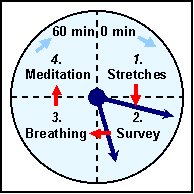|
Home Site Map CDs 7 Skills Flexibility Lifestyle Short course 4 practices Systematic |
||||||||||||||||||||||||
|
|
Steps in Yoga Meditation
The specific stretches or postures, survey or relaxation methods, breathing practices, and types of meditation will also vary, depending on your level of expertise and predispositions. The amount of time spent with each of the practices may vary, depending on your own training and predispositions. The total length of practice (all four) may also vary (The 60-minute clock in the picture above is just an example). Whichever practices are done, and however the time is divided, practicing in this systematic way will definitely provide a deeper and richer meditation. See also
the article: Preparation for the Steps of Meditation Prepare the body physically. Bathe or wash your face, hands, and feet. Empty the bowels and bladder. Have a regular time and place. Establish a lifestyle conducive to meditation. Before doing the actual meditation sequence of stretches, survey, breathing, and meditation, it is most useful to spend some amount of time practicing contemplation, prayer, and/or mantra. This pre-meditation time is also an excellent time to reflect on your day, relationships, priorities in life, and reinforcing your commitment to your spiritual practices. This is a process of internal dialogue, a positive way of self-discussion; it is a two-sided communication with yourself, a dialogue, not just a one-sided monologue, or chattering of the mind. 1. Stretches or Hatha Yoga postures First, do a few simple stretches, or do hatha yoga postures, or do some other form of exercise to loosen the body. Be sure to stay well within your own comfortable capacity. (Within the Yoga system of meditation, the hatha postures are very useful as preparation for meditation, though not absolutely necessary when one wants only to sit for meditation.) 2. Survey of body or Relaxation Next, do some form or relaxation exercise, such as Tension/Release, Complete Relaxation, or 61-Points. Become an explorer, an interior researcher, doing these practices as if you are really curious about knowing yourself at all levels. In a sense, this stage is actually the beginning of meditation (#4), in that you are meditating on the various aspects of the body. One very simple, straightforward way to do this is to simply sit still, without moving, being aware of your ability to move, but that you are not using that ability. Many sensations and thought patterns will naturally arise and pass as you do this. 3. Breathing or Pranayama Next, after the Stretches and Surveying, then regulate your breathing, starting with breath awareness, diaphragmatic breathing, spinal breathing, and alternate nostril breathing. Learn to practice breath awareness in both seated and in corpse postures. Eliminate jerks and pauses, and allow the breath to be quiet and not shallow. Later, you may add energizing practices such as bhastrika and kapalabhati. After working with the body and breath in these ways, the mind wants only to go inside for meditation. 4. Meditation itself After the Stretches, Survey, and Breathing comes Meditation itself. For meditation, first learn to meditate on feeling the touch of breath as it flows in and out of the nostrils, learning to let thoughts come and go. Gradually, allow the conscious mind to still itself. You may wish to use a mantra or sacred word, or some other object of focus (The Soham mantra naturally flows with the breath). Later, learn to examine the unconscious while remaining undisturbed, unaffected, and uninvolved. After learning to meditate on breath, then add meditation in the space between the breasts or eyebrows, depending on your predisposition either for emotions and feelings, or for thoughts and thinking. Follow your predisposition for either listening into the silence for the source of all sound, or watching into the darkness for the source of all light, that which is the source of the part of yourself that declares, “I am”. The are a variety of other categories, objects, or methods of meditation to explore as well within the Yoga system of meditation. Each of them brings progress on the path. Attention The process of Attention moving inward moves through stages: 1. Dharana, or concentration: The effort to repeatedly bring the attention to that one point of focus, while learning to remain undisturbed by the activities of the world, the sensations of the body (though this exploration is a preliminary practice), and the many other streams of the mind (though these are also explored in the purifying process). 2. Dhyana, or meditation: When the attention remains on that one point of focus for a sustained period of time, or said differently, when the same object repeatedly arises in attention, without other intervening thoughts capturing attention, this is called meditation. 3. Samadhi, or absorption: With concentration (dharana) and meditation (dhyana), there are three things: 1) observer, 2) process of observing, and 3) object that is being observed. With deep absorption, or samadhi, it is as if these three collapse into only one, the object. It is as if there is no longer an observer and a process of observing; there is only the object of observation. The three have merged into one, unbroken experience.
-------
|
|
||||||||||||||||||||||
 Yoga
meditation is a
Yoga
meditation is a 

